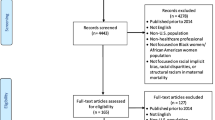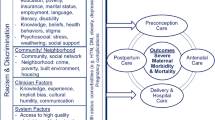Abstract
To explore racial-ethnic disparities in adverse pregnancy outcomes among Medicaid recipients, and to estimate excess Medicaid costs associated with the disparities. Cross-sectional study of adverse pregnancy outcomes and Medicaid payments using data from Medicaid Analytic eXtract files on all Medicaid enrollees in fourteen southern states. Compared to other racial and ethnic groups, African American women tended to be younger, more likely to have a Cesarean section, to stay longer in the hospital and to incur higher Medicaid costs. African-American women were also more likely to experience preeclampsia, placental abruption, preterm birth, small birth size for gestational age, and fetal death/stillbirth. Eliminating racial disparities in adverse pregnancy outcomes (not counting infant costs), could generate Medicaid cost savings of $114 to $214 million per year in these 14 states. Despite having the same insurance coverage and meeting the same poverty guidelines for Medicaid eligibility, African American women have a higher rate of adverse pregnancy outcomes than White or Hispanic women. Racial disparities in adverse pregnancy outcomes not only represent potentially preventable human suffering, but also avoidable economic costs. There is a significant financial return-on-investment opportunity tied to eliminating racial disparities in birth outcomes. With the Affordable Care Act expansion of Medicaid coverage for the year 2014, Medicaid could be powerful public health tool for improving pregnancy outcomes.
Similar content being viewed by others
References
Goldenberg, R. L., et al. (2008). Epidemiology and causes of preterm birth. The Lancet, 371(9606), 75–84.
Mostello, D., et al. (2008). Recurrence of preeclampsia: Effects of gestational age at delivery of the first pregnancy, body mass index, paternity, and interval between births. American Journal of Obstetrics and Gynecology, 199(1), 55.e1–55.e7.
Hjartardottir, S., et al. (2006). Recurrence of hypertensive disorder in second pregnancy. American Journal of Obstetrics and Gynecology, 194(4), 916–920.
Järvelä, I. Y., et al. (2006). Gestational diabetes identifies women at risk for permanent type 1 and type 2 diabetes in fertile age. Diabetes Care, 29(3), 607–612.
Jovanovic, L., & Pettitt, D. J. (2001). Gestational diabetes mellitus. JAMA (Journal of the American Medical Association), 286(20), 2516–2518.
Dyck, R., et al. (2002). A comparison of rates, risk factors, and outcomes of gestational diabetes between aboriginal and non-aboriginal women in the Saskatoon health district. Diabetes Care, 25(3), 487–493.
Hosler, A. S., Nayak, S. G., & Radigan, A. M. (2010). Agreement between self-report and birth certificate for gestational diabetes mellitus: New York State PRAMS. Maternal and Child Health Journal, 14(5), 786–789.
Bloom, B., & Dey, A. N. (2006). Summary health statistics for US children: National Health Interview Survey, 2004. Vital and Health Statistics (Series 10). Data from the National Health Survey (227), 1.
Bloom, B., & Cohen, R. A. (2007). Summary health statistics for US children: National Health Interview Survey, 2006. Vital and Health Statistics (Series 10). Data from the National Health Survey (234), 1.
Foust, R. F., & Carey, B. (2002). Achieving optimal maternal and infant health outcomes for medicaid patients, with application for commercial populations. Managed Care Interface, 15(6), 45–54.
Anum, E. A., et al. (2010). Medicaid and preterm births in Virginia: An analysis of recent outcomes. Journal of Women’s Health, 19(11), 1969–1975.
Mason, M. V., et al. (2011). Effects of a pregnancy management program on birth outcomes in managed Medicaid. Managed Care (Langhorne, Pa), 20(4), 39.
Anum, E. A., Retchin, S. M., & Strauss, J. F., I. I. I. (2010). Medicaid and preterm birth and low birth weight: The last two decades. Journal of Women’s Health, 19(3), 443–451.
Hawkins, M. R. (2005). The impact of a high-risk disease management program on perinatal outcomes in a managed care organization. The Case Manager, 16(4), 59–63.
Howson, C. P. (2009). March of dimes: White paper on preterm birth: The global and regional toll. March of Dimes Foundation.
Xu, X., et al. (2009). Cost of racial disparity in preterm birth: Evidence from Michigan. Journal of Health Care for the Poor and Underserved, 20(3), 729.
Hamilton, B. E., Martin, J. A., & Ventura, S. J. (2006). Births: Preliminary data for 2005. National Vital Statistics Reports, 55(11), 1–18.
Healy, A. J., et al. (2006). Early access to prenatal care: Implications for racial disparity in perinatal mortality. Obstetrics & Gynecology, 107(3), 625.
Xiang, A., et al. (2011). Racial and ethnic disparities in diabetes risk after gestational diabetes mellitus. Diabetologia, 54(12), 3016–3021.
Hunsberger, M., Rosenberg, K. D., & Donatelle, R. J. (2010). Racial/ethnic disparities in gestational diabetes mellitus: Findings from a population-based survey. Women’s Health Issues, 20(5), 323–328.
Koh, H. K. (2010). A 2020 vision for healthy people. New England Journal of Medicine, 362(18), 1653–1656.
Koh, H. K., Graham, G., & Glied, S. A. (2011). Reducing racial and ethnic disparities: The action plan from the Department of Health and Human Services. Health Affairs, 30(10), 1822–1829.
Ananth, C. V., et al. (2005). Trends in preterm birth and perinatal mortality among singletons: United States, 1989 through 2000. Obstetrics & Gynecology, 105(5, Part 1), 1084.
Chang, J., et al. (2003). Pregnancy-related mortality surveillance—United States, 1991–1999. MMWR Surveillance Summaries, 52(2), 1–8.
Wells, N., et al. (2008). The impact of nurse case management home visitation on birth outcomes in African-American women. Journal of the National Medical Association, 100(5), 547.
Satcher, D., et al. (2005). What if we were equal? A comparison of the black-white mortality gap in 1960 and 2000. Health Affairs, 24(2), 459–464.
Hoyert, D. L. (1995). Perinatal mortality in the United States, 1985–1991. US Department of Health and Human Services, Public Health Service, Centers for Disease Control and Prevention, National Center for Health Statistics.
Dominguez, T. P., et al. (2008). Racial differences in birth outcomes: The role of general, pregnancy, and racism stress. Health Psychology, 27(2), 194.
Horsthemke, B., & Ludwig, M. (2005). Assisted reproduction: The epigenetic perspective. Human Reproduction Update, 11(5), 473–482.
Dominguez, T. P. (2008). Race, racism, and racial disparities in adverse birth outcomes. Clinical Obstetrics and Gynecology, 51(2), 360.
McEwen, B. S. (1998). Stress, adaptation, and disease: Allostasis and allostatic load. Annals of the New York Academy of Sciences, 840(1), 33–44.
Harrell, S. P. (2000). A multidimensional conceptualization of racism-related stress: Implications for the well-being of people of color. American Journal of Orthopsychiatry, 70(1), 42–57.
Krieger, N. (2003). Does racism harm health? Did child abuse exist before 1962? On explicit questions, critical science, and current controversies: An ecosocial perspective. Journal Information, 93(2), 194–199.
Cardarelli, K., et al. (2005). Fundamental determinants of population health. In: Aday LA, (Ed.), Reinventing Public Health: Policies and Practices for a Healthy Nation. San Francisco, CA: Jossey-Bass Publishers.
Conley, D. (1999). Being black, living in the red: Race, wealth, and social policy in America. Berkeley, CA: University of California Press.
James, S. A. (2008). Confronting the moral economy of US racial/ethnic health disparities. American Journal of Public Health, 98(Suppl 1), S16.
Lu, M. C., & Halfon, N. (2003). Racial and ethnic disparities in birth outcomes: A life-course perspective. Maternal and Child Health Journal, 7(1), 13–30.
Halfon, N., & Hochstein, M. (2002). Life course health development: An integrated framework for developing health, policy, and research. Milbank Quarterly, 80(3), 433–479.
Kuh, D., et al. (2003). Life course epidemiology. Journal of Epidemiology and Community Health, 57(10), 778.
Willinger, M., Ko, C. W., & Reddy, U. M. (2009). Racial disparities in stillbirth risk across gestation in the United States. American Journal of Obstetrics and Gynecology, 201(5), 469.e1–469.e8.
Martin, J. A., Osterman, M., & Sutton, P. D. (2010). Are preterm births on the decline in the United States? Recent data from the national vital statistics system. NCHS Data Brief, 39, 1.
Thorpe, L. E., et al. (2005). Trends and racial/ethnic disparities in gestational diabetes among pregnant women in New York City, 1990–2001. Journal Information, 95(9), 1536–1539.
Foundation, K. F. (2009). Births of low birthweight as a percent of all births by race/ethnicity. State health comparisons at statehealthfacts.org, 2011. http://www.statehealthfacts.org/comparetable.jsp?ind=43&cat=2&sub=11&yr=92&typ=2&o=a&sortc=2.
Boggess, K. A., et al. (2003). Maternal periodontal disease is associated with an increased risk for preeclampsia. Obstetrics & Gynecology, 101(2), 227.
Michalowicz, B. S., et al. (2006). Treatment of periodontal disease and the risk of preterm birth. New England Journal of Medicine, 355(18), 1885–1894.
Fry-Johnson, Y. W., et al. (2010). United States Black: White infant mortality disparities are not inevitable: Identification of community resilience independent of socioeconomic status. Ethnicity & Disease, 20(1 Suppl 1), S1.
Schlenker, T., & Ndiaye, M. (2009). Apparent disappearance of the Black-White infant mortality gap—Dane County, Wisconsin, 1990–2007. CDC Morbidity and Monthly Weekly Report, 58(20), 561–580.
Acknowledgments
Financial support for this research was provided by the Agency for Healthcare Research and Quality (AHRQ) grant #1R24HS019470 and by a grant from the Healthcare Georgia Foundation.
Conflict of interest
None of the authors have a conflict of interest.
Author information
Authors and Affiliations
Corresponding author
Additional information
This findings have been accepted as poster presentation at AcademyHealth’s 2012 Annual Research Meeting (ARM), June 24–26 at the Walt Disney World Swan and Dolphin Hotel in Orlando, FL, USA.
Disparities in pregnancy outcomes continue to exist. Interventions that reduce or eliminate these disparities may represent economic return on investment.
Rights and permissions
About this article
Cite this article
Zhang, S., Cardarelli, K., Shim, R. et al. Racial Disparities in Economic and Clinical Outcomes of Pregnancy Among Medicaid Recipients. Matern Child Health J 17, 1518–1525 (2013). https://doi.org/10.1007/s10995-012-1162-0
Published:
Issue Date:
DOI: https://doi.org/10.1007/s10995-012-1162-0




